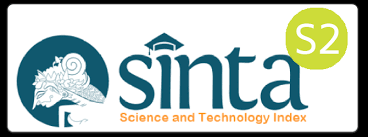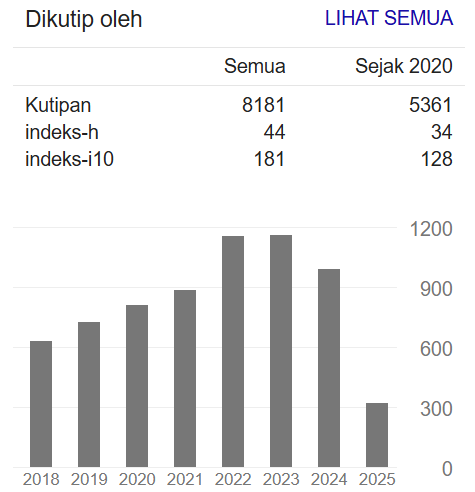THE EFFECT OF COMBINATION RELAX TECHNIQUE AND BASIL AROMATHERAPHY FOR HANDLING ON ANXIETY, DYSMENORRHEA PAIN AND MENSTRUAL PATTERNS IN ADOLESCENT
DOI:
https://doi.org/10.34011/jmp2k.v35i3.3259Keywords:
aromaterapi daun kemangi, dismenore, kecamasan, pola menstruasi, remaja, terapi relaxAbstract
Di usia remaja kecemasan memengaruhi beberapa sistem reproduksi seperti terjadinya disminorea dan mengganggu pola menstruasi. Teknik Relax merupakan terapi alternative berisi self-talk dan deep breathing exercise yang akan dikombinasikan dengan pemberian aromaterapi daun kemangi. Kandungan minyak atsiri dipercaya mampu menjadi perantara antidepresan. Penelitian ini bertujuan untuk mengetahui pengaruh pemberian terapi Relax yang dikombinasikan dengan aromaterapi daun kemangi. Penelitian ini menggunakan jenis penelitian true eksperimen dengan pre and post two groups design. Responden merupakan remaja putri berusia 15-19 tahun dengan jumlah 64, dibagi menjadi 3 kelompok perlakuan dan 1 kelompok kontrol. Analisis hasil penelitian menggunakan uji Wilcoxon, Kruskal Wallis dan Man-Whitney. Hasil analisis pemberian Teknik Relax didapatkan kecemasan (p=0.005), dysmenorrhea (p=0.038), pola menstruasi (p=0.001) yang berarti terdapat pengaruh pemberian Teknik Relax untuk menurunkan kecemasan, dysmenorrhea dan pola menstruasi. Hasil analisis kombinasi Teknik Relax dan aromaterapi daun kemangi didapatkan kecemasan (p=0.001), dysmenorrhea (p=0.000) berarti terdapat pengaruh terapi kombinasi terhadap kecemasan dan nyeri dysmenorrhea sedangkan untuk pola menstruasi (p=0.194) tidak ada pengaruh pemberian terapi kombinasi terhadap pola menstruasi. Sehingga disimpulkan bahwa teknik Relax yang dikombinasikan dengan aromaterapi kemangi efektif mengatasi kecemasan dan nyeri disminorea tetapi tidak efektif pada pola menstruasi. Hasil uji Mann-Whitney menunjukkan tidak ada perbedaan signifikan antara kedua terapi dalam mengurangi kecemasan (p=0,539) dan dismenore (p=0,527), yang menunjukkan efektivitas yang sebanding. Namun terdapat perbedaan signifikan untuk pola menstruasi (p=0,003) pada terapi Relax. Dapat disimpulkan kedua terapi berpengaruh terhadap kecemasan dan dysmenorrhea tetapi hanya terapi Relax yang berpengaruh pada pola menstruasi.
References
S. M. Sawyer, P. S. Azzopardi, D. Wickremarathne, and G. C. Patton, “The age of adolescence,” Lancet Child Adolesc Health, vol. 2, no. 3, pp. 223–228, Mar. 2018, doi: 10.1016/S2352-4642(18)30022-1.
M. Iqbal and L. Rizqulloh, “Deteksi Dini Kesehatan Mental Akibat Pandemi Covid-19 Pada Unnes Sex Care Community Melalui Metode Self Reporting Questionnaire,” Praxis, vol. 3, no. 1, p. 20, Sep. 2020, doi: 10.24167/praxis.v3i1.2730.
N. Z. Gustina, I. A. Badri, and Y. D. Putri, “Hubungan Peer Support Dengan Tingkat Kecemasan Mahasiswa Akhir Studi di Kota Batam,” J Ris Kes Nas, vol. 7;(2), pp. 150–155, Oct. 2023, doi: DOI:https://doi.org/10.37294.
A. Ridha, P. Siagian Putri, R. Roro, and M. A. Ningtyas, “Transformasi Kesehatan Mental : Tantangan dan Upaya Kebijakan Pemerintah Pada Masa Pandemi COVID-19,” Promotor, vol. 6, no. 1, pp. 37–44, 2023, doi: ElseraCc.NyeriHaidDanKecemasanRemajaPutri.JurnalKeperawatan.2022;14(4):1107–16.
Ghozalba Iqbal, Marfuah, and A. Y. Salam, “Hubungan Komunikasi Terapeutik Perawat Dengan Kecemasan Keluarga Pasien di Ruang IGD Triase Kuning UPT Puskesmas Penanggal,” JK, vol. 18;(1), pp. 55–57, Jan. 2025, doi: https://doi.org/10.56586/jk.v18i1.380.
D. F. Cahyani and N. S. Putri, “Liberosis: Jurnal Psikologi dan Bimbingan Konseling Dampak Kecemasan Berlebihan Terhadap Psikologis Gen Z (Usia Remaja),” Liberosis : Jurnal Psikologi dan Bimbingan Konseling, vol. 3, no. 3, pp. 82–94, 2024, doi: 10.3287/liberosis.v3i3.4244.
S. Xie, X. Zhang, W. Cheng, and Z. Yang, “Adolescent anxiety disorders and the developing brain: Comparing neuroimaging findings in adolescents and adults,” Gen Psychiatr, vol. 34, no. 4, pp. 1–9, 2021, doi: 10.1136/gpsych-2020-100411.
E. M. Cherenack and K. J. Sikkema, “Puberty- and Menstruation-Related Stressors Are Associated with Depression, Anxiety, and Reproductive Tract Infection Symptoms Among Adolescent Girls in Tanzania,” Int J Behaf Med, vol. 29, no. 2, pp. 160–174, Apr. 2022, doi: 10.1007/s12529-021-10005-1.
R. Itani, L. Soubra, S. Karout, D. Rahme, L. Karout, and H. M. J. Khojah, “Primary Dysmenorrhea: Pathophysiology, Diagnosis, and Treatment Updates,” May 2022, Korean Journal of Family Medicine. doi: 10.4082/kjfm.21.0103.
World Health Organization, “World Health Report,” Geneva, May 2020. Accessed: Jun. 08, 2025. [Online]. Available: https://iris.who.int/bitstream/handle/10665/332070/9789240005105-eng.pdf?sequence=1
E. Christiana, N. Nindawi, and Y. R. Mufida, “Derajat Disminorea Pada Mahasiswi DIII Keperawatan yang Mengalami Obesitas di Politeknik Negeri Madura,” SAKTI BIDADARI (Satuan Bakti Bidan Untuk Negeri), vol. 6, no. 2, pp. 84–89, Sep. 2023, doi: 10.31102/bidadari.2023.6.2.84-89.
A. D. P. Hernanto, A. A. Polim, and Vetinly, “Does Lifestyle Affect Dysmenorrhea Intensity? A Cross-Sectional Study,” Indonesian Journal of Obstetrics and Gynecology, vol. 10, no. 3, pp. 121–126, Jul. 2022, doi: 10.32771/inajog.v10i3.1559.
W. Wahyuni and U. Zulfahmi, “Prevalensi dan Gambaran Karakteristik Dismenorea pada Remaja,” J Sex Reprod Heal, vol. 1, no. 1, pp. 1–13, Dec. 2021, doi: 10.53088/griyawidya.v1i1.104.
S. Iqbal, F. Aljanoubi, and S. A. Alzarah, “Menstrual Cycle Relation With Anxiety And Other Psychological Symptoms in Woman,” Pharmaceutical Science, pp. 120–130, Jan. 2021, doi: 10.5281/zenodo.4543209.
RISKESDAS, “Laporan Riskesdas 2018 Nasional,” 2018. Accessed: Jun. 08, 2025. [Online]. Available: https://layanandata.kemkes.go.id/katalog-data/riskesdas/ketersediaan-data/riskesdas-2018
D. E. Martini, L. Maghfuroh, H. S. Aisyah, and D. P. Sari, “The Correlation of Body Mass Index and the onset of menarche with the menstrual cycle in young women at Pondok Assalafi Nurul Huda Sugio District,” J Med Kom Ilmu Kes, vol. 14, no. 2, pp. 61–69, Aug. 2022, doi: 10.38040/js.v14i2.
N. O. S. Nurdin, J. J. E. Wantania, and R. A. A. Mewengkang, “Assosiation between Serum Cortisol Levels and Anxiety levels In Elective and Emergency Cesarean Section,” Indones J Obstet Gynecol, vol. 10, no. 4, pp. 205–210, Oct. 2022.
N. A. Rahmawati, A. Z. Q. A’yun, and S. A. Ma’rufah, “Deep Breathing Exercise on the Anxiety Level of Tuberculosis Patients in Dau District,” JIKA, vol. 6, no. 1, pp. 122–128, Apr. 2024, doi: 10.36590/jika.v6i1.564.
L. Toussaint et al., “Effectiveness of Progressive Muscle Relaxation, Deep Breathing, and Guided Imagery in Promoting Psychological and Physiological States of Relaxation,” Evid Based Complement Alternat Med, vol. 5924040, Jul. 2021, doi: 10.1155/2021/5924040.
I. A. Putri, M. Fatimura, Husnah, and M. Bakrie, “Pembuatan Minyak Atsiri Kemangi (Ocimum Basilicum L.) Dengan Menggunakan Metode Distilasi Uap Langsung,” J Redoks, vol. 6, no. 2, pp. 146–156, Dec. 2021, doi: https://doi.org/10.31851/redoks.v6i2.5202.
V. Gradinariu, O. Cioanca, L. Hritcu, A. Trifan, E. Gille, and M. Hancianu, “Comparative efficacy of Ocimum sanctum L. and Ocimum basilicum L. essential oils against amyloid beta (1–42)-induced anxiety and depression in laboratory rats,” Phytochemistry Reviews, vol. 14, no. 4, pp. 567–575, Aug. 2015, doi: 10.1007/s11101-014-9389-6.
Notoatmodjo, “pdf-metodologi-penelitian-kesehatan-notoatmodjo_compress,” 2018.
S. M. Nugent, T. I. Lovejoy, S. Shull, S. K. Dobscha, and B. J. Morasco, “Associations of Pain Numeric Rating Scale Scores Collected during Usual Care with Research Administered Patient Reported Pain Outcomes,” Pain Medicine (United States), vol. 22, no. 10, pp. 2235–2241, Oct. 2021, doi: 10.1093/pm/pnab110.
E. S. Damirchi, A. Mojarrad, S. Pireinaladin, and A. M. Grjibovski, “The Role of Self-Talk in Predicting Death Anxiety, Obsessive-Compulsive Disorder, and Coping Strategies in the Face of Coronavirus Disease (COVID-19),” Iran J Psychiatry, vol. 15, no. 3, pp. 182–188, 2020, doi: https://doi.org/10.18502/ijps.v15i3.3810.
M. Sabzipour, S. Mousavi, and M. R. Shahsavari, “Effect of Positive Self-Talk Training on Depression Alleviation in Students with Suicidal Ideation,” Int J School Health, vol. 10, no. 2, pp. 62–68, Apr. 2023, doi: 10.30476/INTJSH.2023.98029.1289.
M. Malikul Mulki, Ta’adi, and L. Sunarjo, “Effectiveness of Deep Breath Relaxation Techniques and Music Therapy on Reducing Anxiety Level among Pre-operative Patients,” IJNHS, vol. 4, no. 1, pp. 59–65, Feb. 2020, doi: 10.35654/ijnhs.v4i1.389.
A. B. Handy, S. F. Greenfield, K. A. Yonkers, and L. A. Payne, “Psychiatric Symptoms Across the Menstrual Cycle in Adult Women: A Comprehensive Review,” Harv Rev Psychiatry, vol. 30, no. 2, pp. 100–117, Dec. 2021, doi: 10.1097/HRP.0000000000000329.
M. Wegerer, H. Kerschbaum, J. Blechert, and F. H. Wilhelm, “Low levels of estradiol are associated with elevated conditioned responding during fear extinction and with intrusive memories in daily life,” Neurobiol Learn Mem, vol. 116, pp. 145–154, Dec. 2014, doi: 10.1016/j.nlm.2014.10.001.
S. T. Sigmon, D. M. Dorhofer, K. J. Rohan, and N. E. Boulard, “The Impact of Anxiety Sensitivity, Bodily Expectations, and Cultural Beliefs on Menstrual Symptom Reporting: A Test of the Menstrual Reactivity Hypothesis,” J Anxiety Disord, vol. 14, no. 6, pp. 615–633, Nov. 2000, doi: https://doi.org/10.1016/S0887-6185(00)00054-2.
T. Ummah and Ismarwati, “The impact of complementary therapies on dysmenorrhea in young women,” Maj Obs Gin, vol. 32, no. 1, pp. 29–38, Apr. 2024, doi: 10.20473/mog.v32i12024.29-38.
Maryam, M. A. Ritonga, and Istriati, “Relationship between Menstrual Profile and Psychological Stress with Dysmenorrhea,” Althea Medical Journal, vol. 3, no. 3, pp. 382–387, Sep. 2016, doi: 10.15850/amj.v3n3.884.
W. Wahyuni and F. K. U. Maghfiroh, “The effect of deep breathing exercise in minimizing pain level of primary dysmenorrhea,” Int J Health Sci (Qassim), pp. 11745–11753, Jun. 2022, doi: 10.53730/ijhs.v6ns3.8828.
A. S. Çelik and S. E. Apay, “Effect of progressive relaxation exercises on primary dysmenorrhea in Turkish students: A randomized prospective controlled trial,” Complement Ther Clin Pract, vol. 42, pp. 1–6, Feb. 2021, doi: 10.1016/j.ctcp.2020.101280.
M. Kim, K. Sowndhararajan, S. J. Park, and S. Kim, “Effect of inhalation of isomers, (+)-α-pinene and (+)-β-pinene on human electroencephalographic activity according to gender difference,” Eur J Integr Med, vol. 17, pp. 33–39, Jan. 2018, doi: 10.1016/j.eujim.2017.11.005.
D. S. Kim et al., “Olfactory Stimulation with Volatile Aroma Compounds of Basil (Ocimum basilicum L.) Essential Oil and Linalool Ameliorates White Fat Accumulation and Dyslipidemia in Chronically Stressed Rats,” Nutrients, vol. 14, no. 9, May 2022, doi: 10.3390/nu14091822.
S. Hong et al., “Inhalation of low-dose basil (Ocimum basilicum) essential oil improved cardiovascular health and plasma lipid markers in high fat diet-induced obese rats,” J Food Sci, vol. 1, no. 1, pp. 1–5, Jul. 2022, doi: https://doi.org/10.1111/1750-3841.16196.
N. N. Ayuob, M. J. Balgoon, S. Ali, I. S. Alnoury, H. M. ALmohaimeed, and A. A. AbdElfattah, “Ocimum basilicum (Basil) Modulates Apoptosis and Neurogenesis in Olfactory Pulp of Mice Exposed to Chronic Unpredictable Mild Stress,” Front Psychiatry, vol. 11, Sep. 2020, doi: 10.3389/fpsyt.2020.569711.
S. J. Hong et al., “Exploration of basil (Ocimum basilicum) essential oil profiles using E-nose and GC–MS combined with GC-O and inhalation effects on the human EEG topography and tomography (s-LORETA) and blood pressure,” J Funct Foods, vol. 112, Jan. 2024, doi: 10.1016/j.jff.2023.105918.
S. Raveendran and Smitha, “Effect of Basil Water in Reducing Symptoms of Dysmenorrhea:An Experimental Study,” GJRA, vol. 5, no. 6, pp. 243–244, Jun. 2016, doi: https://www.doi.org/10.36106/gjra.
A. Prasad et al., “Depressive symptoms and their relationship with endogenous reproductive hormones and sporadic anovulation in premenopausal women,” Ann Epidemiol, vol. 24, no. 12, pp. 920–924, Dec. 2014, doi: 10.1016/j.annepidem.2014.10.005.
N. Nurhayati, S. S, and S. H. Hamang, “Depo Medroxyprogesterone Acetate (DMPA): Long-Term Effects on Menstrual Cycle Disorders,” Indonesian Journal of Obstetrics and Gynecology, vol. 11, no. 2, pp. 93–98, Apr. 2023, doi: 10.32771/inajog.v11i2.1884.
B. Purushothaman, R. Prasannasrinivasan, P. Suganthi, B. Ranganathan, J. Gimbun, and K. Shanmugam, “A comprehensive review on Ocimum basilicum,” Journal of Natural Remedies, vol. 18, no. 3, pp. 71–85, Jul. 2018, doi: 10.18311/jnr/2018/21324.
N. S. Azizah et al., “Sweet Basil (Ocimum basilicum L.) A Review of Its Botany, Phytochemistry, Pharmacological Activities, and Biotechnological Development,” Plants, vol. 12, no. 24, pp. 1–25, Dec. 2023, doi: 10.3390/plants12244148.
N. Sut and H. Kahyaoglu-Sut, “Effect of aromatherapy massage on pain in primary dysmenorrhea: A meta-analysis,” Complement Ther Clin Prac, vol. 27, pp. 5–10, May 2017, doi: 10.1016/j.ctcp.2017.01.001.
M. N. Najafi et al., “The Effect of Aromatherapy Alone or in Combination with Massage on Dysmenorrhea: A Systematic Review and Meta-analysis,” Dec. 01, 2021, Georg Thieme Verlag. doi: 10.1055/s-0041-1740210.
Downloads
Published
How to Cite
Issue
Section
Citation Check
License
Copyright (c) 2025 Nanda Agnesia Jati Pratiwi, Rezha Alivia Hildayanti, Dian Hanifah, Harisatul Hasanah

This work is licensed under a Creative Commons Attribution-ShareAlike 4.0 International License.




